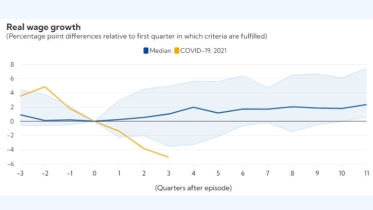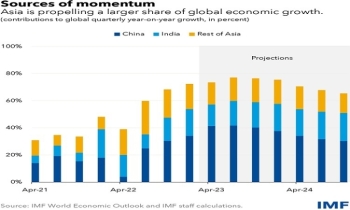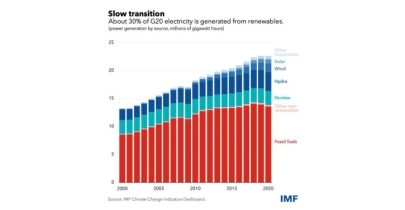Central banks can fend off financial turmoil and still fight inflation
IMF Blog || BusinessInsider

Photo: Representational
Recent events have shown central banks and policymakers can deal with sizable financial stress without compromising their inflation-fighting stance.
Regulators and central banks were able to contain contagion from the collapse of Silicon Valley Bank and other US regional banks, as well as Credit Suisse in Switzerland, without retreating on the inflation front. The same is true of the Bank of England’s actions to halt the selloff in bond markets that followed the UK government’s tax-cut proposal last September.
In times of acute financial stress and high inflation, though, policy trade-offs are more challenging.
During the 2008 global financial crisis, policies in pursuit of price and financial stability were aligned. As economic activity faltered, the primary question for price stability was how to support aggregate demand to avoid deflation and recession. On the financial stability side, the main concern was to avoid deeper financial distress. Aggressive easing of monetary policy allowed the simultaneous pursuit of both objectives.
With inflation now stubbornly high, the two objectives may clash. Central banks have had to raise policy interest rates aggressively to cool activity and bring inflation back to target. After a long period of low and stable inflation and interest rates, many financial institutions had grown complacent about maturity and liquidity mismatches. Rapidly rising interest rates have stressed the balance sheets of exposed bank and nonbank financial institutions through declining values of their fixed-income assets and increased funding costs. Left unmitigated, these could threaten overall financial stability.
How should central banks navigate this difficult trade-off? Conceptually, we propose to distinguish between times when financial stress remains modest, and times of heightened financial stress or acute financial crises.
Handling modest financial stress
Past episodes of monetary policy tightening have often generated financial stress. Provided these stresses remain modest, they shouldn’t pose much of a challenge to achieving both price and financial stability objectives. Increases in the policy rate transmit to the real economy in part by raising borrowing costs for households and firms. If such modest financial stress leads to an unexpected weakening of aggregate demand, the policy rate path can be adjusted, keeping output and inflation broadly on the same trajectory. Central banks have taken this approach in the past. For example, the US Federal Reserve put a hold on raising rates in the early 1990s when it faced a looming credit crunch, even though inflation was running well above desired levels.
In addition, tools other than the policy rate can be used to contain financial stress. For example, emergency lending at the discount window or via emergency liquidity facilities can provide support while macroprudential tools, where available, could be loosened. In principle, the use of relatively standard financial stability tools—without the need for additional fiscal support—should be sufficient in the case of a modest rise in financial stress, allowing monetary policy to focus on inflation.
The challenges of heightened financial stress
Even when financial stresses may seem contained for some time, a number of developments can create adverse nonlinear feedback loops and quickly develop into a full-blown systemic financial crisis, a process that was hastened in the recent bank collapses by technology and social media.
Such an environment presents very difficult challenges for central banks. Forceful and timely action by policymakers is required through aggressive financial policies. These include various forms of liquidity support, asset purchases, or possibly direct capital injections. Sufficiently forceful, these interventions could leave monetary policy free to maintain its focus on inflation.
Critically, the actions needed to forestall a crisis may extend beyond what central banks can do alone. While central banks can extend broad-based liquidity support to solvent banks, they are not equipped to deal with the problems of insolvent firms or borrowers, which must be addressed by governments. The need for aggressive financial interventions becomes more acute as financial stresses intensify and insolvency risks grow, and often requires committing sizeable fiscal resources.
This is illustrated in a recent episode in Korea. When the default of a real estate developer last September triggered sharp disruptions in short-term funding markets, the Korean government responded with market support measures, including a corporate bond-buying program, while the Bank of Korea provided substantial liquidity support. These actions allowed the central bank to raise its policy rate in pursuit of its inflation objectives.
When governments lack fiscal space or political support to provide resources, risk management concerns may induce central banks to adjust their monetary policy reaction function to account for financial stress. Specifically, more prudence in raising rates is needed to reduce the risks of an adverse and potentially nonlinear reaction of the financial system. Under these conditions, while central banks should remain committed to price stability, they could tolerate a somewhat slower return of inflation to target. Uncertainties about balance sheet exposures, intermediaries’ connectedness, and self-fulfilling market reactions to policy moves push in the same direction.
Of course, the reduced focus on inflation may be difficult to communicate, possibly heightening the sense of crisis. Moreover, it may leave central banks well behind the curve in fighting inflation or at the mercy of ‘financial dominance’. Hence the bar should be high in communicating such a shift in the reaction function, especially when inflation is still raging. The preferred course of action should be to rely on financial policies or to restore fiscal support.
In countries with limited monetary policy credibility and weak fiscal positions, policy options are far more limited. These countries are more vulnerable to broad-based depositor flight that triggers a sharp exchange rate depreciation and high inflation. If available, authorities can deploy measures requiring real resources (foreign exchange interventions, equity injections) but if a crisis is imminent, they may have to turn to capital management tools, notwithstanding potentially adverse reputational effects. Policy options can be further narrowed by investor concerns about the vulnerability of the financial sector.
When the financial crisis is acute
Should financial conditions deteriorate into a systemic crisis—with a sharp downturn in economic activity expected to ensue—central banks would clearly want to prioritise restoring financial stability. Central banks with high credibility could ease monetary policy, and if inflation was still running high, indicate that they would be more flexible about the time frame for returning inflation to target. In practice, the materialisation of a crisis would likely put substantial downward pressure on inflation, thus realigning monetary and financial policy objectives.
But emerging markets with weaker macro policy frameworks would likely have to confront the very difficult challenges posed by capital flight and currency depreciation-inflation spirals. Their central banks would have to remain vigilant about the need to maintain a nominal anchor, limiting any scope to ease. While these countries could take some steps on their own (for example, with capital flow management measures), a strong international safety net is vital to mitigate the risk of a prolonged and severe crisis.
Supporting nonbanks
The rising importance and criticality of nonbank financial institutions, such as insurance firms, pension funds and investment funds, present important challenges. Typically, central banks provide liquidity through the banking system, but this liquidity may not reach nonbanks. They are often less well capitalized and subject to weaker prudential regulation and supervision, so that central banks have less scope to reduce moral hazard risks in the first place. Yet, in periods of heightened or acute financial stress, central banks may need to provide liquidity to nonbanks, as they did during the global financial crisis and the COVID-19 pandemic. However, the bar on lending to nonbanks should be higher than for banks because of the greater risks to central banks’ balance sheets and the risk of creating incentives that could increase future financial instability.
In sum
In practice, the boundaries between the different scenarios are fuzzy. Uncertainty about the health of the financial system and its resilience to monetary tightening will inevitably complicate central banks’ decision processes. However, through the lens of our proposed taxonomy, the recent events in Switzerland, the United Kingdom and the United States suggest that the forceful responses by authorities to heightened financial stress helped reduce financial instability and allowed central banks to maintain their inflation fighting stance.
























